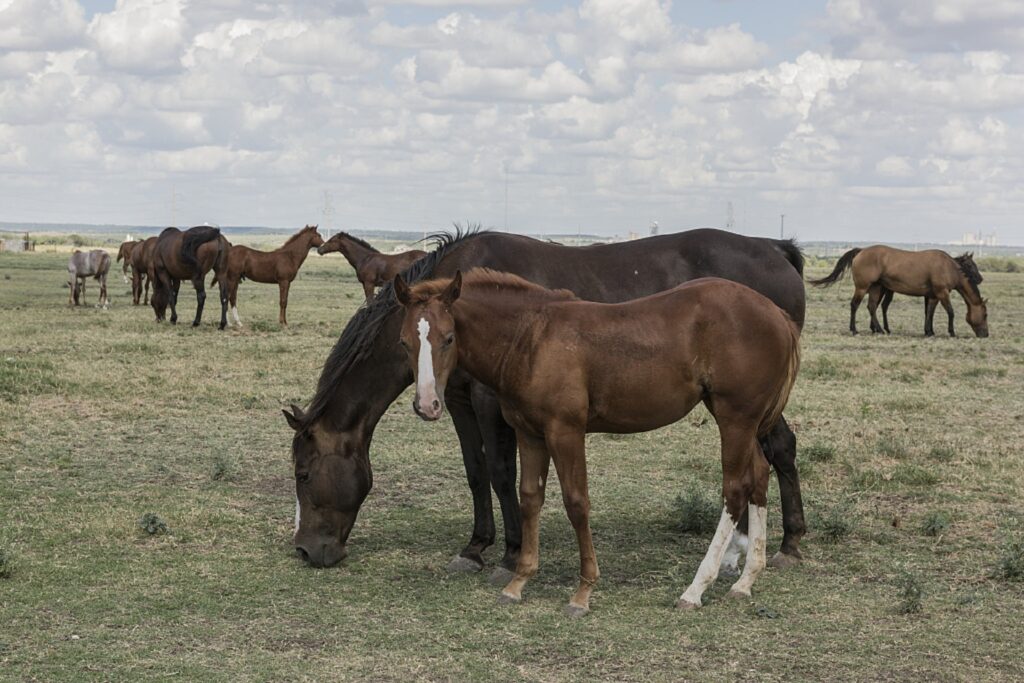
What are the top five fastest land animals?
In this article we are going to take a look at the top five fastest land animals in the world. Now there may be other faster animals in the air or water, but we will look to cover them in a separate article.
In the animal kingdom it’s either kill or be killed. So if you’ve not developed your own camouflage, deadly defences or happen to be so big that the predators leave you alone, then being able to run fast to escape is really going to come in handy!

5 – American Quarter Horse (55mph/88kph)


The American Quarter Horse is a breed renowned for its exceptional speed, particularly over short distances, making it one of the fastest animals in the world. Known for its ability to sprint a quarter mile (hence the name “Quarter Horse”) faster than any other horse breed, the American Quarter Horse can reach speeds of up to 55 mph (88 kph). This incredible burst of speed, combined with its agility and versatility, has made the Quarter Horse a favorite in various equestrian sports and a key part of American ranching culture.
The American Quarter Horse’s remarkable speed is a product of its unique lineage and selective breeding. The breed traces its origins back to the 17th century when early settlers in America began crossbreeding English Thoroughbreds with local Native American horses, including those of Spanish descent. The resulting breed inherited the best qualities of its ancestors: the Thoroughbred’s speed and the sturdy build and stamina of the Native American horses. Over time, breeders focused on enhancing the Quarter Horse’s ability to sprint over short distances, leading to the development of the modern American Quarter Horse known for its explosive acceleration and top-end speed.
This breed’s physical attributes are perfectly suited for sprinting. The American Quarter Horse has a compact, muscular body with powerful hindquarters that generate immense propulsion. Its legs are short and strong, enabling quick bursts of speed and rapid changes in direction. This makes the Quarter Horse not only fast but also incredibly agile.
In addition to its speed, the American Quarter Horse is known for its calm temperament and intelligence, qualities that make it highly trainable and reliable. These traits have contributed to the breed’s popularity, not just in racing and rodeo sports but also in ranch work and general riding. Whether herding cattle or competing in a race, the Quarter Horse’s speed and agility make it an invaluable partner.
The American Quarter Horse’s dominance in short-distance racing has been well-documented in events such as Quarter Horse racing, where these horses often compete in races covering 220 to 870 yards. In these competitions, the breed consistently outperforms others, cementing its reputation as one of the fastest animals on land.
In summary, the American Quarter Horse’s combination of speed, power, and versatility makes it a standout among the world’s fastest animals.
4 – Springbok (55mph/88kph)


The springbok (Antidorcas Marsupialis) is a small, graceful antelope native to the open plains of southern Africa, and it holds a special place in the animal kingdom as one of the world’s fastest land animals. Capable of reaching speeds up to 55 mph (88 kph), the springbok is known not only for its speed but also for its remarkable agility.
The springbok’s speed and agility are crucial adaptations that have evolved to help it evade predators in its harsh environment. In the wild, the springbok faces a host of predators, including cheetahs, leopards, and lions. To survive, it relies on a combination of speed and an extraordinary behavior known as “pronking.” During pronking, the springbok leaps into the air with all four feet off the ground, sometimes reaching heights of up to 9 ft (2.7 m). This behavior, which often includes a series of high, stiff-legged jumps, is thought to serve multiple purposes. It may be a way to show strength and vitality to predators, a signal to other springboks that danger is near, or simply a method of confusing and evading predators during a chase.
The springbok’s anatomy is finely tuned for speed. It has long, slender legs that allow it to take long strides, covering large distances quickly. Its body is lightweight and aerodynamically shaped, minimizing resistance as it runs. The springbok’s muscles are highly efficient at utilizing oxygen, allowing it to sustain high speeds for longer periods than many other animals.
In addition to its physical prowess, the springbok is well-adapted to the arid environments of southern Africa. It can go for long periods without water, obtaining most of its moisture from the plants it eats. This ability to thrive in dry conditions, coupled with its speed, makes the springbok a successful species in some of the most challenging habitats on Earth.
3 – Pronghorn Antelope (55mph/89kph)


The pronghorn antelope (Antilocapra Americana), often simply called the pronghorn, is one of the most remarkable creatures in North America, known for its extraordinary speed and endurance. This unique animal, often mistaken for a true antelope, is actually the only surviving member of the family Antilocapridae. The pronghorn is widely celebrated as one of the fastest land animal in the world, capable of reaching speeds of up to 55 mph (89 kph), making it the fastest animal in the Western Hemisphere.
What makes the pronghorn’s speed particularly fascinating is not just its top speed but its ability to maintain high speeds over long distances. While the cheetah, the world’s fastest land animal, can only maintain its peak speed for short bursts of about 20 to 30 seconds, the pronghorn is capable of sustaining speeds of 30 to 40 mph (48 to 64 kph) for several miles. This incredible endurance is a result of the pronghorn’s evolutionary history, which is deeply intertwined with the now-extinct North American cheetah. The pronghorn’s speed evolved as a survival mechanism to evade this predator, which roamed the plains of North America during the last Ice Age. Even though the North American cheetah has been extinct for thousands of years, the pronghorn’s speed remains, a testament to its evolutionary arms race with one of history’s most formidable hunters.
The pronghorn’s physiology is perfectly adapted for speed. It has a lightweight, aerodynamic body, with long, slender legs that can cover great distances in a single stride. Furthermore, the pronghorn’s hooves are designed for traction, preventing it from slipping on the loose soil of the prairies and deserts it inhabits.
The pronghorn is not just a marvel of speed but also an icon of the American West. It inhabits a wide range of environments, from the grasslands and sagebrush flats of Wyoming and Montana to the deserts of Arizona and New Mexico. Despite the challenges posed by these harsh environments, the pronghorn thrives, thanks to its incredible speed, keen eyesight, and adaptability. Its large, forward-facing eyes give it a wide field of vision, allowing it to detect predators from a great distance.
The pronghorn antelope is more than just a symbol of speed; it is a living relic of a bygone era, a creature whose remarkable abilities have allowed it to survive and thrive in some of the most challenging environments on Earth. Its continued presence on the North American plains is a reminder of the rich biodiversity that once existed and the ongoing importance of conserving these incredible species.
2 – Ostrich (60mph/97kph)


The ostrich (Struthio Camelus) is an extraordinary bird, renowned for being the largest and heaviest living bird on Earth. Yet, despite its inability to fly, the ostrich is one of the fastest land animals, capable of reaching impressive speeds of up to 60 mph (97 kph) in short bursts, with sustained speeds of 30 to 40 mph (48 to 64 kph) over longer distances. This remarkable speed, combined with its powerful legs and distinctive physical features, makes the ostrich a marvel of natural engineering and an essential figure in the animal kingdom.
The ostrich’s speed is primarily due to its long, powerful legs, which are perfectly adapted for running. Each leg has two toes, with one toe being much larger and resembling a hoof. This unique adaptation provides the ostrich with a strong and stable footing, allowing it to propel itself forward with significant force. The ostrich’s legs are also equipped with powerful muscles, enabling the bird to take strides of up to 12 to 15 feet (3.6 to 4.6 meters) with each step. This long stride length, combined with rapid leg movements, is key to the ostrich’s ability to cover large distances quickly.
Another factor contributing to the ostrich’s speed is its lightweight, yet robust body. Although the ostrich can weigh up to 320 pounds (145 kilograms), its body is streamlined and balanced, reducing wind resistance as it runs. The ostrich’s small wings act as stabilizers, allowing the bird to make sharp turns or sudden stops without losing control.
The ostrich’s speed and agility are not just tools for escaping predators but also play a role in its social behaviour. During courtship displays, male ostriches often perform elaborate dances that include running and rapid movements, demonstrating their strength and speed to attract females. This combination of speed and display is essential for mating success in ostrich populations.
However, the ostrich’s reliance on speed comes with certain challenges. While it is highly effective at outrunning many predators, such as lions and hyenas, it is not invincible. Young ostriches and eggs are particularly vulnerable to predation, and even adults can fall prey if caught off guard. Despite these challenges, the ostrich’s speed remains one of its most vital survival tools, allowing it to thrive in the harsh environments of Africa’s savannas and deserts.
In summary, the ostrich is not only the largest bird in the world but also one of the fastest land animals. Its exceptional speed, powered by its long, muscular legs and supported by its keen eyesight and agile body, allows it to navigate and survive in its environment with remarkable efficiency, making it one of the most fascinating creatures in the animal kingdom.
1 – Cheetah (70mph/113kph)


The cheetah (Acinonyx Jubatus) holds the title of the fastest land animal, a distinction that sets it apart in the animal kingdom. Capable of reaching speeds of up to 60 to 70 miles per hour (97 to 113 kilometres per hour), the cheetah is a marvel of evolution, specifically designed for bursts of unparalleled speed. This incredible ability makes it an exceptional predator, perfectly adapted to the open grasslands and savannas where it hunts.
The cheetah’s speed is a result of its unique physiological features, all of which are finely tuned to optimize speed and acceleration. The cheetah’s lightweight, aerodynamic body, and long legs are integral to its high-speed. Its spine is highly flexible, acting like a spring, allowing the cheetah to stretch its body out and cover significant ground with each stride. During a chase, a cheetah can cover 20 to 25 feet in a single stride, and it can take up to four strides per second.
Its muscular, long legs enable powerful, fast strides, while semi-retractable claws provide extra grip on the ground, akin to the spikes on a runner’s shoes. The cheetah’s tail acts as a rudder, helping it make sharp turns and maintain balance during high-speed pursuits.
Despite its speed, the cheetah’s hunting strategy is not just about running fast. Cheetahs rely on stealth and patience, often stalking their prey to within 100 to 200 feet before beginning their sprint. This element of surprise is crucial because, despite its speed, a cheetah can only maintain its top speed for about 20 to 30 seconds. The extreme physical exertion quickly leads to overheating, so the cheetah must catch its prey within this narrow window of time.
Interestingly, the cheetah’s reliance on speed comes with trade-offs. Unlike other big cats, the cheetah is built more for speed than strength, meaning it often struggles to protect its kills from larger predators like lions, hyenas, and even leopards.
Sadly, this remarkable animal is facing significant threats in the wild, with habitat loss, human-wildlife conflict, and declining prey populations leading to a decrease in its numbers. Conservation efforts are crucial to preserving the cheetah’s place in the natural world, where it remains an iconic symbol of speed and grace.
